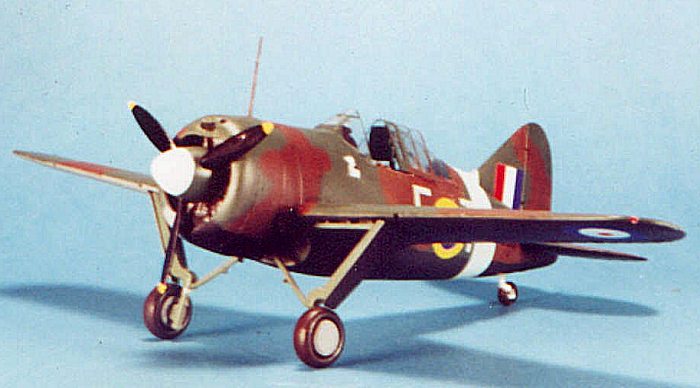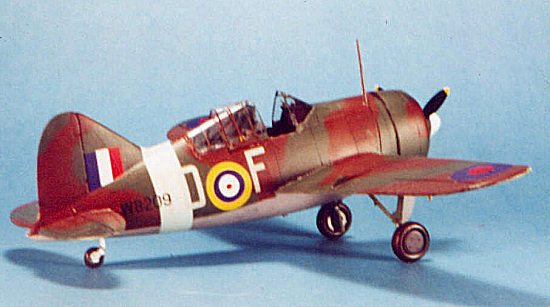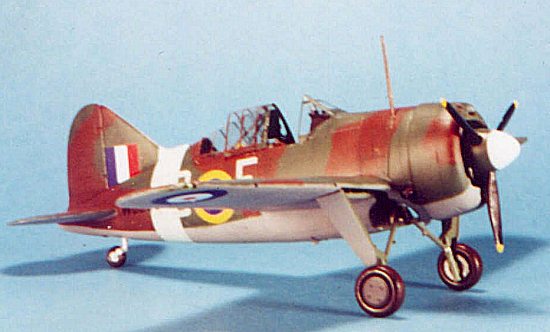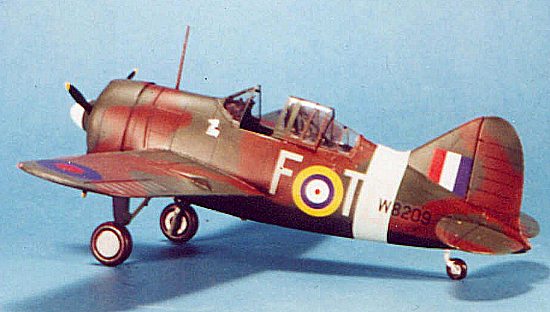
Tamiya 1/48 Buffalo I
|
KIT # |
61031 |
|
PRICE: |
$23.98 MSRP |
|
DECALS: |
See Review |
|
REVIEW : |
Tom Cleaver |
|
NOTES: |
Red Roo Conversion set |
THE NOT-SO-BENIGHTED BUFFALO:
Making a British Buffalo Mk. I from the 1/48 Tamiya kit

|
HISTORY |
How the Brewster Airplane Company, better known as a 19th century buggy manufacturer, obtained the contract to build the U.S. Navy's first modern all-metal monoplane fighter is one of those mysteries that will never be completely resolved. The Grumman competitor, the XF4F-2, was close enough in performance to the XF2A-1 as to leave little choice, and Grumman had a track record with the Navy for producing the FF-1, F2F-1 and the F3F series of fighters. Within six months of the contract being let, the Navy had cause to regret the decision when it became apparent that Brewster had no idea what the term "series production" meant (the finished airplanes had to be lifted out of the ancient buggy factory by crane and lowered two stories to the street below, then towed six blocks to the airfield for testing); fortunately the Navy came to its senses in time for the Grumman Wildcat to be developed to the point where it would be one of the great fighters of history, while the Brewster product would be excoriated by nearly everyone who flew it in combat, other than a few Finns.
In fact, the Buffalo was not as horrible as legend would have it, if one sticks to the F2A-1 and F2A-2 types and their export counterparts; even the overweight, underpowered F2A-3 - which suffered from growth in weight when such items as armor plate and self-sealing fuel tanks were added in, without any increase in power - was not appreciably worse than its Wildcat stablemate. Much of the problem with the combat record of the Buffalo can be put down to inexperienced pilots using incorrect tactics against an enemy they neither knew nor understood.
 The Finns were
fortunate to fly what was the best version of all, the F2A-1, a lightweight
airplane for which the 900 h.p. R-1820 provided adequate power. Coupled with the
fact that the airplane was not up against first-class aerial opposition in
either aircraft or pilots (the Russians were using I-16s and I-153s on the
Finnish front as late as the fall of 1942, with a small number of U.S. supplied
P-40s in Murmansk) the well-trained Finns were able to register one of the best
kill-loss ratios of any fighter used in the Second World War. Marion Carl, a
pilot who knew a thing or two about the subject - having flown the F2A-3 with
VMF-221 at Midway - once told me that "outside of weak landing gear, the
Buffalo was as good as the Wildcat, which was also outperformed by the
opposition, if you knew how to take advantage of what it could do. We could
probably have scored as well as we did at Guadalcanal with the pilots we had and
Buffalos as we did with Wildcats."
The Finns were
fortunate to fly what was the best version of all, the F2A-1, a lightweight
airplane for which the 900 h.p. R-1820 provided adequate power. Coupled with the
fact that the airplane was not up against first-class aerial opposition in
either aircraft or pilots (the Russians were using I-16s and I-153s on the
Finnish front as late as the fall of 1942, with a small number of U.S. supplied
P-40s in Murmansk) the well-trained Finns were able to register one of the best
kill-loss ratios of any fighter used in the Second World War. Marion Carl, a
pilot who knew a thing or two about the subject - having flown the F2A-3 with
VMF-221 at Midway - once told me that "outside of weak landing gear, the
Buffalo was as good as the Wildcat, which was also outperformed by the
opposition, if you knew how to take advantage of what it could do. We could
probably have scored as well as we did at Guadalcanal with the pilots we had and
Buffalos as we did with Wildcats."
Of course, the event for which the Buffalo has been under a cloud ever since is the defense of Singapore. 170 Brewster Model 339Es, the export equivalent of the F2A-2, were ordered by the British Purchasing Commission in January 1940. Almost all of these were shipped to Singapore in the summer and fall of 1941, in the shadow of the pending Pacific War. Legend has it that the Japanese Zeros shot the Buffalos out of the sky like clay pigeons.
So much for the legends.
In fact, the Zero never took part in the fighting over Singapore. The RAF was opposed by the Japanese Army Air Force, which was primarily equipped with the Nakajima Ki.27, a fighter a generation older than the Buffalo; only one unit of the JAAF - the 64th Sentai under the legenday Major Tateo Kato - was equipped with the Ki.43 Hayabusa (Oscar) during this period. The fact this airplane had retractable gear and a bubble canopy caused much confusion with the Zero, since Allied intelligence knew virtually nothing about their Japanese opponents. (It is only in the past year that members of the A.V.G. finally concluded that they were fighting Ki.27s and Ki.43s - not Zeros - in the defense of Rangoon and have stopped calling historian Dan Ford nasty names for so discovering.)
The other half of the legend is also wrong. The RAF was right that the Buffalo could outperform the Ki.27 on all points other than maneuverability. Had the Commonwealth pilots defending Singapore with Buffalos had the benefit of being led by Claire Chennault and used his hit-and-run tactics, as well as enough time to come to know their mounts, they might have done better. As it was - inexperience, bad tactics, poor reliability and all - they actually scored a 2:1 victory tally over the JAAF. Whenever a Buffalo could hold a Ki.27 or a Ki.43 in its sights long enough to loose a burst, the effect of 4 .50 caliber heavy machine guns was almost always fatal to the lightly-constructed Japanese fighters, while the Buffalo was particularly hard to kill for pilots armed with 2 rifle-caliber machine guns. The big problem for the Commonwealth pilots and their Buffalos was that a 2:1 victory ratio still leaves you the loser when you are outnumbered 10:1.
In fact, the Buffalo Mk.I was not a poor performer when compared to other Allied warplanes of the time. With armor plate and self-sealing fuel tanks, it weighed 600 pounds more than the F2A-2. The increase weight brough maximum speed down to 330 mph and maximum climb down to 3,000 fpm; in fact these are better performance figures than the Wildcat that fought over Guadalcanal and not that far off the Curtiss P-40C Tomahawk and directly comparable to the Hurricane that "replaced" it in the final days over Singapore. The airplane's real Achilles heel was the fact that Brewster could not obtain sufficient supplies of new-production Wright R-1820 Cyclone engines, due to the rapid expansion of the U.S. aircraft industry in the period 1939-41. Brewster was forced to purchase used Cyclones from airlines flying the DC-3; the engines were remanufactured to R-1820-G105 standards, but were never the same as new and created numerous maintenance problems during their service life. Additionally, the Buffalo Mk.I did not use the same fuel line pressurization equipment as the F2A-2, and frequently experienced fuel starvation above 18,000 feet. Small items like engine unreliability and inability to operate at combat altitudes will tend to put a dent in one's operational performance.
 When the Buffalos
arrived at Singapore beginning in May 1941, the RAF instituted a plan to form
five Commonwealth squadrons on the type, primarily from the Royal Australian and
New Zealand Air Forces. They would be completely outnumbered when the war came.
32 Buffalos - half held in reserve - of 67 Squadron RAF formed the entire air
defense of Rangoon, the main resupply port for all British forces in southeast
Asia. Nos. 21 and 243 (RAF), 453 (RAAF) and 488 (RNZAF) Squadrons formed the air
defense of Singapore, "Gibraltar of the Pacific," with a total of 64
operational fighters. A shortage of pilots prevented the formation of more
squadrons, and a number of Buffalos were placed in storage. The pilots of these
units were mostly inexperienced, with only a few veterans among them, and had
less than three months after being declared operational to learn how to
effectively use their aircraft before being thrown into the cauldron of war; by
that time, 20 of the Buffalos were write-offs in training.
When the Buffalos
arrived at Singapore beginning in May 1941, the RAF instituted a plan to form
five Commonwealth squadrons on the type, primarily from the Royal Australian and
New Zealand Air Forces. They would be completely outnumbered when the war came.
32 Buffalos - half held in reserve - of 67 Squadron RAF formed the entire air
defense of Rangoon, the main resupply port for all British forces in southeast
Asia. Nos. 21 and 243 (RAF), 453 (RAAF) and 488 (RNZAF) Squadrons formed the air
defense of Singapore, "Gibraltar of the Pacific," with a total of 64
operational fighters. A shortage of pilots prevented the formation of more
squadrons, and a number of Buffalos were placed in storage. The pilots of these
units were mostly inexperienced, with only a few veterans among them, and had
less than three months after being declared operational to learn how to
effectively use their aircraft before being thrown into the cauldron of war; by
that time, 20 of the Buffalos were write-offs in training.
Even so, the Buffalo did well at the outset. 453 Squadron was credited with 5 Ki.27s on December 13, 1941. The units were also tasked with ground support of Commonwealth forces on the Malayan peninsula. On January 12, 1942, 453 Squadron made a strafing attack on advancing Japanese troops that inflicted high casualties and stopped the advance for two days. Even though five Commonwealth Buffalo pilots became aces during this period, combat attrition wore down the units; by February 1942, even the infusion of Hurricanes was too little, too late, and the survivors were evacuated to the Netherlands East Indies where they would continue to fight a losing rearguard action.
In Rangoon, 67 Squadron fought alongside the American Volunteer Group, but without the advantage of the Tigers' tactics. The commander, the outstandingly-incompetent RAF Air Marshal Donald Stevenson - known in England as "Butcher Stevenson" for his wastage of Blenheim crews on impossible daylight missions during his tenure as AOC 2 Group - said that any RAF pilot seen to dive away from a fight (the correct tactic) would be court-martialed for cowardice, proving conclusively that the RAF would have done better in World War 2 if every officer over the rank of Air Vice Marshal other than Hugh Dowding and Keith Park been court-martialed for incompetence in 1940 (of course, Dowding was retired to obscurity as soon as he won the Battle of Britain, and Park was exiled to Malta for showing up the fallacy of the Trenchardites' belief that "the bomber will always get through").
Exemplary of the spirit of the pilots who attempted the impossible over Singapore was Sergeant M.N. "Mac" Read of 453 Squadron, whose personal airplane was Buffalo Mk.I W8209 TD-F, "Snifter." Over Singapore on December 22, 1941, Sgt. Read ran out of ammunition in a fight with Ki.43 Hayabusas of the 64th Sentai. He turned his Buffalo toward his opponent and scored his victory the hard way, ramming the Hayabusa head on.
|
THE KIT |
The Tamiya Buffalo was as far ahead of its competition when it was released in 1974 (if memory serves) as were the Tamiya releases of the 1990s. As with the later releases, it also gave modelers heart attacks with its incredible price: a whole US $12.50 when the competition was going for well under US$5.00. That kit was particularly good, with enough parts to do either an F2A-2 or a Model 339E RAF Buffalo I or Model 339D Dutch Buffalo. The cockpit was so good it was the 1974 equivalent of the Hasegawa Ki.84 or N1K1-J kits of the past year. The model set a standard that it took the competition ten years to equal.
 In 1998, the kit was
re-released by Tamiya after being out of production for several years.
Unfortunately, Tamiya in its wisdom decided to forego the parts necessary to
make anything but the F2A-2, and any modeler wanting the make the Buffalo Mk.I
was forced to pay collector's prices for the earlier kits. Interestingly, the
kit goes for a price of $23.98, which is comparable to the latest
state-of-the-art kits, and - at least to my mind - a case of price gouging since
the molds have long since been amortized in production.
In 1998, the kit was
re-released by Tamiya after being out of production for several years.
Unfortunately, Tamiya in its wisdom decided to forego the parts necessary to
make anything but the F2A-2, and any modeler wanting the make the Buffalo Mk.I
was forced to pay collector's prices for the earlier kits. Interestingly, the
kit goes for a price of $23.98, which is comparable to the latest
state-of-the-art kits, and - at least to my mind - a case of price gouging since
the molds have long since been amortized in production.
In 1999, Gary Byk at Red Roo Models came to the rescue with a resin conversion set to make the Buffalo Mk.I. This included a resin tail cone, land-based tailwheel, correct seat, armor, and a very nice Falcon vacuform canopy, which would allow the modeler to open the canopy. This was followed in 1999 by a set of very good decals to make "Snifter," the Buffalo flown by Sgt. Read of 453 Squadron on December 22, 1941. The decals were also accompanied by new research regarding the actual colors the Buffalo was delivered in, these being US "equivalent colors" rather than the RAF colors previously thought to be correct.
Having won one of the new-release Buffalos at TamiyaCon two years ago, when I got hold of the Red Roo conversion and decal sheet, I decided to make Sergeant Read's airplane.
|
CONSTRUCTION |
The Tamiya kit is very simple and well-engineered, having set the standard Tamiya would become famous for 17 years later. Even with raised panel lines, the kit is still impressive out of the box, and falls together in construction. I did rescribe the raised panel lines on the kit.
Following the Red Roo instructions on painting, I painted the cockpit interior British Interior Green (which it might not have been) and painted it Dull Dark Green on the areas under the canopy outside the cockpit proper (there is a good chance these areas might have been "Bell Green," since Bell Aircraft was also in Buffalo, and was ordering a lot of paint at the time - again, no real proof).
I Futured the canopy, cut it open with my trusty Xacto, and glued the windscreen and rear canopy in place once the model was assembled.
|
PAINT & DECALS |
I first "shadow shaded" the model with flat black airbrushed over the panel lines, and painted the port wing and lower fuselage half flat black. I then "faded" this area with Gunze-Sanyo RLM66 Black Grey, so that it was not monochromatic.
 Red Roo says that the
Buffalo's lower surfaces were painted Sky Grey, and that the upper surfaces were
painted in U.S. Medium Green and an equivalent "Dark Earth" color that
was close to RAF Dark Earth but more brown. This accords with new information
about the colors Bell was busy painting their Airacobra Is and Curtiss was
painting their Tomahawks across town; it strikes me that Brewster would have
used the locally-available colors, which were already being used for RAF
aircraft. To do this, I used Tamiya "Sky Grey," Gunze-Sanyo H-302
Green FS34092, and Gunze-Sanyo Dark Earth with a bit of Tamiya Flat Brown mixed
in. The Sky fuselage band was done using Tamiya "Sky" after I had
painted the camouflage colors. Red Roo also provides a painting diagram for the
upper surfaces, which makes the job very easy. I did this freehand, since I made
the historical guess that Brewster would have done their patterns freehand, the
same way Bell was doing at the same time (and not with the masks Curtiss was
using, since Brewster was already behind schedule on the contract).
Red Roo says that the
Buffalo's lower surfaces were painted Sky Grey, and that the upper surfaces were
painted in U.S. Medium Green and an equivalent "Dark Earth" color that
was close to RAF Dark Earth but more brown. This accords with new information
about the colors Bell was busy painting their Airacobra Is and Curtiss was
painting their Tomahawks across town; it strikes me that Brewster would have
used the locally-available colors, which were already being used for RAF
aircraft. To do this, I used Tamiya "Sky Grey," Gunze-Sanyo H-302
Green FS34092, and Gunze-Sanyo Dark Earth with a bit of Tamiya Flat Brown mixed
in. The Sky fuselage band was done using Tamiya "Sky" after I had
painted the camouflage colors. Red Roo also provides a painting diagram for the
upper surfaces, which makes the job very easy. I did this freehand, since I made
the historical guess that Brewster would have done their patterns freehand, the
same way Bell was doing at the same time (and not with the masks Curtiss was
using, since Brewster was already behind schedule on the contract).
Decals:
Once the model was dry, I Futured it, and when that was dry I applied the Red Roo decals. At first I thought the red was a bit bright, but then considered that these were done in America, where the RAF "brick red" was not likely available. The decals are thin and go down like MicroScale decals.
|
FINAL ASSEMBLY |
When the decals were set, I washed the model to get rid of solvent stain, and shot another coat of Future. I followed that up with several coats of "Flat Future," a 70-30 mix of Future and Tamiya Flat Base, then applied exhaust stains and gunport stains with Tamiya "Smoke." I peeled off the Scotch Tape masks from the canopy, glued the sliding portion in position, and then made the antenna using nylon repair thread. I muddied the wheels and then glued the landing gear in position.
|
CONCLUSIONS |
For a kit that is over 25 years old in original conception, the Tamiya Buffalo holds up amazingly well. With the Red Roo conversion and decals, you can make a very accurate representation of a "Singapore Defender," and with the new information on U.S. "equivalent colors" you can get the colors right, too, and not have to pay "collector's prices" to get the right kit.
Editor's note: The early boxing F2A Buffalo kit that have the bits for a model 339 are a lot more easily available that one would think, the editor buying two of these kits recently from vendors at a model contest. They cost less than the current kit. All you have to do is look around.
If you would like your product reviewed fairly and fairly quickly, please contact the editor or see other details in the Note to Contributors.